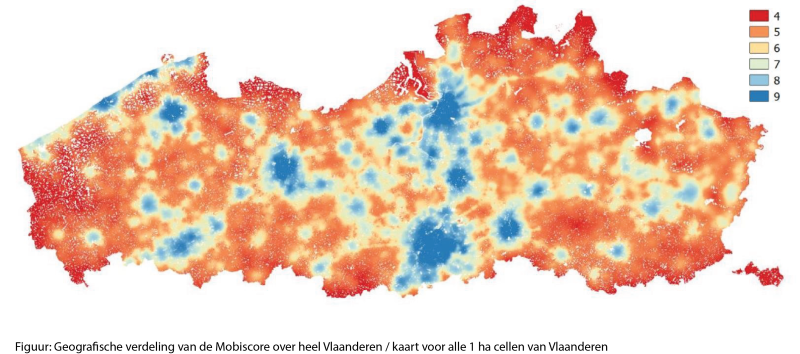Mobiscore
16065 / 19044 / 20028 / 21008
From 2017 to 2019
Mobiscore is a tool that assesses a property's accessibility based on sustainable mobility, with the aim of making residents aware of the mobility impact of their place of residence. TML developed the methodology behind Mobiscore and led the project to achieve an objective and user-friendly end result.
Mobiscore is a tool that assigns an accessibility score to a house or plot of land. The score indicates how well different facilities (train station, bus stop, school, ...) are accessible in a sustainable way - i.e. on foot and/or by bicycle. The tool was launched in June 2019.
With the development of Mobiscore, the Department of the Environment wants to make people aware of the mobility impact of choosing where to live. After all, the ecological footprint of an average Flemish family is higher than in neighbouring countries. This is mainly due to the high number of vehicle kilometres per inhabitant, a number linked to our place of residence and the ways in which we can travel to work, shop, spend our leisure time, etc.
The decision to buy or rent a place to live is an influential moment when behavioural change can be prompted. By aggregating this information and offering it on the Mobiscore website (www.mobiscore.be), prospective buyers can easily compare locations. A location's score can also be displayed (via an API) directly on real estate websites.
TML developed the underlying methodology for this tool and directed the other project partners to achieve an objective, informative, guiding, and graphically attractive result.
Follow-up study
Six months after the Mobiscore was launched, TML, in collaboration with the Environment Department, conducted an in-depth analysis. The aim of this follow-up study was not only to understand the current Mobiscore, but also to understand the sensitivity of the various parameters, and on that basis to make proposals for an improved Mobiscore that is better aligned with policy objectives.
Update
In 2019, TML analysed the Mobiscore to understand the factors leading to differences between scores and why certain neighbourhoods score more or less than expected. The study focused on exploring the sensitivity of the parameters and formulating improvements to better align the Mobiscore with policy objectives.
To this end, the environmental costs underlying the Mobiscore were recalculated with updated data, while the original methodology was largely retained. An updated Mobiscore was then developed based on these new environmental costs. This score was compared with both the original Mobiscore and an alternative score calculation to identify differences and areas for improvement and make recommendations.
Mobiscore is a tool that assigns an accessibility score to a house or plot of land. The score indicates how well different facilities (train station, bus stop, school, ...) are accessible in a sustainable way - i.e. on foot and/or by bicycle. The tool was launched in June 2019.
With the development of Mobiscore, the Department of the Environment wants to make people aware of the mobility impact of choosing where to live. After all, the ecological footprint of an average Flemish family is higher than in neighbouring countries. This is mainly due to the high number of vehicle kilometres per inhabitant, a number linked to our place of residence and the ways in which we can travel to work, shop, spend our leisure time, etc.
The decision to buy or rent a place to live is an influential moment when behavioural change can be prompted. By aggregating this information and offering it on the Mobiscore website (www.mobiscore.be), prospective buyers can easily compare locations. A location's score can also be displayed (via an API) directly on real estate websites.
TML developed the underlying methodology for this tool and directed the other project partners to achieve an objective, informative, guiding, and graphically attractive result.
Follow-up study
Six months after the Mobiscore was launched, TML, in collaboration with the Environment Department, conducted an in-depth analysis. The aim of this follow-up study was not only to understand the current Mobiscore, but also to understand the sensitivity of the various parameters, and on that basis to make proposals for an improved Mobiscore that is better aligned with policy objectives.
Update
In 2019, TML analysed the Mobiscore to understand the factors leading to differences between scores and why certain neighbourhoods score more or less than expected. The study focused on exploring the sensitivity of the parameters and formulating improvements to better align the Mobiscore with policy objectives.
To this end, the environmental costs underlying the Mobiscore were recalculated with updated data, while the original methodology was largely retained. An updated Mobiscore was then developed based on these new environmental costs. This score was compared with both the original Mobiscore and an alternative score calculation to identify differences and areas for improvement and make recommendations.



